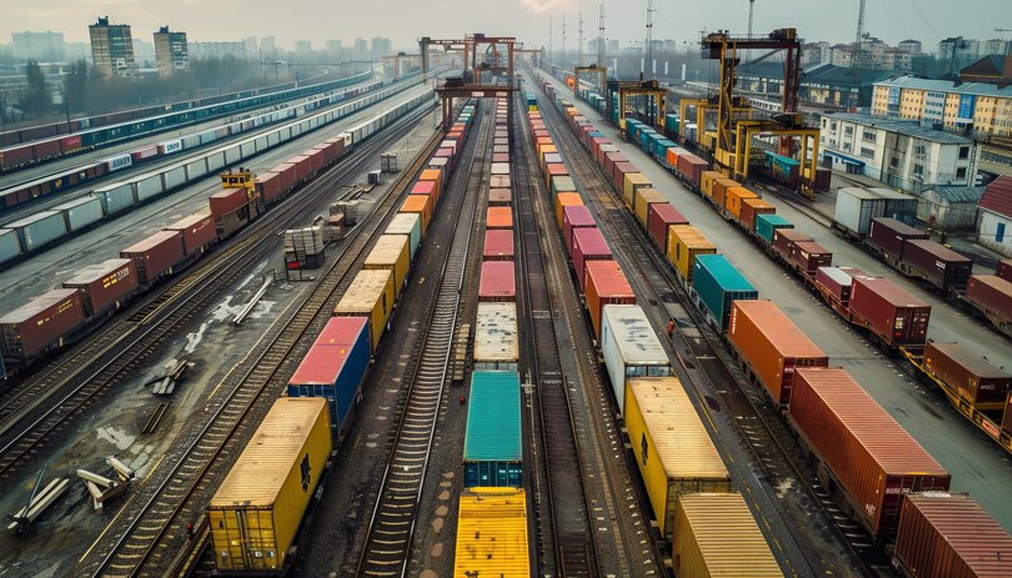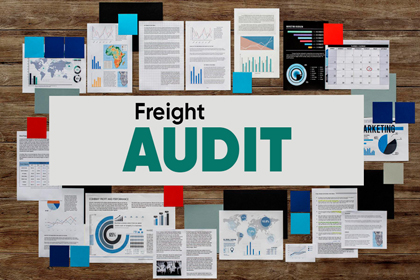Railway freight has long been a critical component of logistics and supply chain networks worldwide. It is an efficient and cost-effective method of transporting bulk goods over long distances, offering benefits like reduced environmental impact and the ability to move large volumes of cargo at once. In this blog, we’ll dive into the importance of railway freight in the logistics industry, how it operates, and the challenges and opportunities that come with it.

Importance of Railway Freight in Logistics
1.Cost Efficiency
Railways offer a significant cost advantage over other forms of transportation, particularly for bulk goods like coal, minerals, chemicals, and food products. This cost efficiency stems from the ability to transport large volumes of cargo in a single trip, which reduces per-unit costs for shippers.
2. Sustainability
Rail transport is known for being more environmentally friendly than road or air transportation. Trains are more fuel-efficient and produce fewer emissions per ton-kilometer compared to trucks or planes. This makes railway freight a key component of sustainable logistics strategies, especially for companies aiming to reduce their carbon footprints.
3. Capacity and Scalability
Rail freight systems are built to handle heavy and oversized goods that cannot be easily moved by other means. A single freight train can carry the load of several hundred trucks, which is why industries that need to transport commodities like iron ore, steel, and grain heavily rely on rail.
4. Reliability
Railway freight is less prone to weather delays, traffic congestion, or driver shortages, which often affect road transport. This reliability makes it a popular choice for long-haul logistics, where consistent, predictable delivery times are crucial.
How Railway Freight Operates
1.Types of Goods Moved
Railway freight is ideal for bulk commodities such as coal, oil, agricultural products, and construction materials. It also serves industries that require the transport of vehicles, machinery, and containers.
2.Infrastructure and Equipment
The railway freight system relies on an extensive network of tracks, rail yards, and stations, all supported by specialized equipment such as locomotives, wagons, and cranes. Freight wagons are designed to carry specific types of goods, including open wagons for bulk materials, tank wagons for liquids, and flatbed wagons for containers.
3.Intermodal Freight Transport
One of the biggest innovations in railway freight is intermodal transportation. This involves the use of more than one mode of transport, typically combining rail with road or sea. Containers are the main units used in intermodal transport, allowing for seamless movement between ships, trucks, and trains. This system improves efficiency by minimizing handling and reducing the risk of damage to goods.
4. Scheduling and Coordination
Railway freight scheduling is a complex process that involves multiple stakeholders, including rail operators, shippers, and infrastructure managers. Freight trains often share tracks with passenger trains, which requires careful planning to ensure that all services run smoothly without delays. Modern railway systems increasingly use advanced technology like GPS tracking and automated scheduling systems to optimize train operations.
Challenges Facing Railway Freight
Despite its many advantages, railway freight is not without its challenges. Understanding these hurdles is key to improving and expanding the railway network for freight services.
1. Infrastructure Limitations
Rail infrastructure in many regions is outdated and requires significant investment to improve. This includes not only the tracks and stations but also the signaling systems and maintenance facilities. In countries with well-developed rail networks, ongoing maintenance is a costly necessity. In contrast, in developing regions, inadequate infrastructure can limit the effectiveness of rail freight.
2. Competition from Road and Air Transport
While rail freight offers advantages for certain types of goods, it faces stiff competition from road and air transport for smaller, time-sensitive, or high-value cargo. Trucks are often faster for short distances, and air freight is preferable for urgent shipments. As a result, rail freight must continually adapt to stay competitive, especially in regions where road infrastructure is highly developed.
3. Limited Flexibility
Rail freight operates on fixed schedules and routes, which makes it less flexible than road transport. Trucks can deliver goods directly to the customer’s door, while trains rely on terminals and rail yards. For this reason, rail freight is often used in combination with road transport for the final leg of delivery.
4. Regulatory Hurdles
Railway freight is heavily regulated, with strict safety and environmental standards that must be met. Additionally, cross-border rail freight faces challenges related to differing national regulations, track gauges, and customs procedures, all of which can cause delays and add to operational complexity.
5. Labor and Operational Costs
Although rail is cost-effective for moving bulk goods over long distances, the operational costs can still be significant, especially in terms of labor and fuel. Strikes, labor shortages, or disputes can affect the reliability of freight services.
Future of Railway Freight
1. Technological Advancements
The future of railway freight looks promising, with several technological advancements poised to revolutionize the industry. Autonomous trains, for example, are already being tested in several countries. These driverless trains can reduce labor costs and improve safety by minimizing human error. Additionally, the integration of smart technologies, such as real-time tracking and predictive maintenance systems, is helping to optimize train performance and reduce downtime.
2. Green Initiatives
As industries focus more on sustainability, railway freight is likely to become a key player in reducing global carbon emissions. The push toward electrifying rail networks is already underway in many countries, with governments and private companies investing in cleaner, more energy-efficient locomotives. In the future, rail could play a larger role in reducing reliance on fossil fuels in transportation.
3.Expansion of High-Speed Rail Freight
While high-speed rail is generally associated with passenger services, there is growing interest in using high-speed trains for freight transport. This would enable faster delivery times for time-sensitive goods, such as fresh food or perishable items, while maintaining the cost and environmental benefits of rail.
4.Global Trade and Connectivity
The growth of international trade, particularly in regions like Asia and Europe, is driving demand for enhanced railway connectivity. Projects like China’s Belt and Road Initiative are expanding rail links across multiple continents, offering new opportunities for railway freight to connect markets that were previously difficult to reach by road or sea.
Conclusion
Railway freight remains a vital part of global logistics, offering a range of benefits from cost efficiency to sustainability. While it faces competition from other modes of transport and challenges such as infrastructure limitations and regulatory hurdles, the future is bright for rail freight. With the integration of new technologies and ongoing investment in infrastructure, rail is set to remain a key player in the logistics industry for decades to come.
For companies looking to optimize their supply chains and reduce costs, incorporating railway freight into their logistics strategies can provide significant advantages. NaaviQ TMS can help businesses streamline this process by offering advanced solutions for transportation management, ensuring that goods move efficiently across networks and other modes of transport. Reach out to us today to learn how we can enhance your logistics operations and take full advantage of the benefits that we offer.




